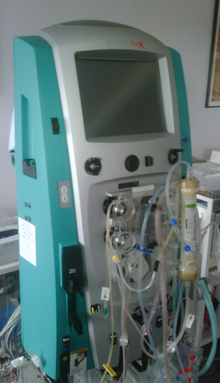User:MikalaB
Rhabdomyolysis Treatment
[edit]Overview of Injury
[edit]In the treatment of rhabdomyolysis, there are several important therapies that are essential to recovery: fluid replacement via intravenous therapy, pharmacological interventions, dialysis, and rest. Based on the literature, the consensus indicates that fluid replacement is the most effective treatment following rhabdomyolysis [1][2][3][4][5]. Rehydration assists in re-establishing blood and fluid flow to the kidneys for filtration of myoglobin and increased urine production [6]. In addition, fluid replacement acts to negate the pooling of fluid within the damaged muscle tissue by increasing the drain rate of fluid and minimize the effects of decreased renal filtration as well as reduce the likelihood of developing compartment syndrome in the affected region [7]
Fluid Replacement
[edit]While intravenous fluid replacement remains the most prominent treatment option, current research regarding additional consequences of rhabdomyolysis is expanding and improving the quality of treatment. Boutaud and Roberts discovered that the inhibition of lipid peroxidation through pharmacological methods reduced free radical tissue damage as well as reverse vasoconstriction, which was caused by decreased blood flow to the kidneys from excess fluid pooling as previously discussed[8]. Furthermore, treatment can potentially include urine alkalinization to counteract acidification of the blood following free radical perfusion, prevention of nephrotoxicity, and management of hyperkalemia, hyperphosphatemia, and hypocalcemia [9]. An improvement in the status of the aforementioned abnormalities via intravenous therapies, oral administration, and hemodialysis facilitates restoration of kidney function and initiates the healing process for the damaged tissues [10].

Hemodialysis
[edit]In patients with severe rhabdomyolysis, it may become necessary to use more invasive treatment protocols such as hemodialysis to filter the blood and remove excess myoglobin [11] to improve the filtration status of the kidney and maintain rehydration [12]. Overall, fluid replacement, suspension of exercise and activity, and rest are effective in treating mild forms of rhabdomyolysis [13].

Physical Therapy
[edit]Once treatment is completed, rehabilitation via physical therapy is recommended. The breakdown of muscle that occurs during the acute event causes movement deficits, especially in the affected region. Following the healing of tissue damage, therapeutic interventions for the previously damaged tissues are essential. Progressive exercises specific to the area of damaged tissue act to reactivate the healed muscle fibers and increase overall innervation to the tissues.

References
[edit]- ^ Al-Ismaili, Z., Piccioni, M., & Zappitelli, M. (2011). Rhabdomyolysis: Pathogenesis of renal injury and management. Pediatric Nephrology, 26, 1781-1788. doi: 10.1007/s00467-010-1727-3
- ^ Bosch, X., Poch, E., & Grau, J. M. (2009). Rhabdomyolysis and acute kidney injury. The New England Journal of Medicine, 361, 62-72.
- ^ Boutaud, O. & Roberts, L. J. (2011). Mechanism-based therapeutic approaches to rhabdomyolysis-induced renal failure. Free Radical Biology & Medicine, 51, 1062-1067. doi: 10.1016/j.freeradbiomed.2010.10.704
- ^ Chatzizisis, Y. S., Misirli, G., Hatzitolios, A. I., Giannoglou, G. D. (2008). The syndrome of rhabdomyolysis: Complications and treatment. European Journal of Internal Medicine, 19, 568-574. doi: 10.1016/j.ejim.2007.06.037
- ^ Cleary, M. A., Sadowski, K. A., Lee, S. Y.-C., & Miller, G. L. (2011). The Journal of Strength and Conditioning Research, 25(12), 3506-3513.
- ^ Chatzizisis, Y. S., Misirli, G., Hatzitolios, A. I., Giannoglou, G. D. (2008). The syndrome of rhabdomyolysis: Complications and treatment. European Journal of Internal Medicine, 19, 568-574. doi: 10.1016/j.ejim.2007.06.037
- ^ Al-Ismaili, Z., Piccioni, M., & Zappitelli, M. (2011). Rhabdomyolysis: Pathogenesis of renal injury and management. Pediatric Nephrology, 26, 1781-1788. doi: 10.1007/s00467-010-1727-3
- ^ Boutaud, O. & Roberts, L. J. (2011). Mechanism-based therapeutic approaches to rhabdomyolysis-induced renal failure. Free Radical Biology & Medicine, 51, 1062-1067. doi: 10.1016/j.freeradbiomed.2010.10.704
- ^ Chatzizisis, Y. S., Misirli, G., Hatzitolios, A. I., Giannoglou, G. D. (2008). The syndrome of rhabdomyolysis: Complications and treatment. European Journal of Internal Medicine, 19, 568-574. doi: 10.1016/j.ejim.2007.06.037
- ^ Chatzizisis, Y. S., Misirli, G., Hatzitolios, A. I., Giannoglou, G. D. (2008). The syndrome of rhabdomyolysis: Complications and treatment. European Journal of Internal Medicine, 19, 568-574. doi: 10.1016/j.ejim.2007.06.037
- ^ Chatzizisis, Y. S., Misirli, G., Hatzitolios, A. I., Giannoglou, G. D. (2008). The syndrome of rhabdomyolysis: Complications and treatment. European Journal of Internal Medicine, 19, 568-574. doi: 10.1016/j.ejim.2007.06.037
- ^ Al-Ismaili, Z., Piccioni, M., & Zappitelli, M. (2011). Rhabdomyolysis: Pathogenesis of renal injury and management. Pediatric Nephrology, 26, 1781-1788. doi: 10.1007/s00467-010-1727-3
- ^ Thomas, D. Q., Carlson, K. A., Marzano, A., & Garrahy, D. (2012). Exertional rhabdomyolysis: what is it and why should we care? Journal of Physical Education, Recreation & Dance, 83(1), 46-51. doi: 10.1080/07303084.2012.10598711
